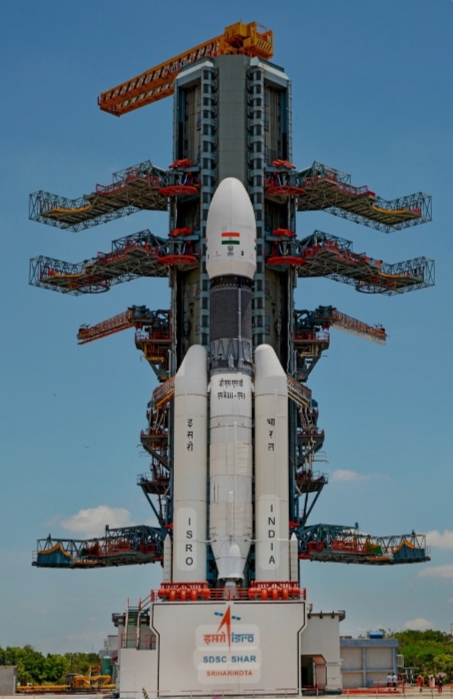“Mission Accomplished: ISRO CMS-03 Satellite Powers India’s Naval Communication Future”
ISRO has successfully launched CMS-03 — its heaviest communications satellite to date — aboard the LVM3-M5 rocket from Sriharikota. The flight was the fifth operational mission for the LVM3 vehicle and placed the 4,410-kg satellite into a geo-synchronous transfer orbit. Equipped with multi-band capability, CMS-03 will deliver vital communications coverage across oceanic regions and the Indian landmass for both civilian and strategic applications.
About ISRO CMS-03 Satellite: Next-Generation Communication Powerhouse
Compared with the legacy GSAT-7 “Rukmini,” CMS-03 offers significantly expanded footprint and increased bandwidth capacity, ensuring low-latency, real-time communications across remote and contested sea regions.
The Indian Space Research Organisation (ISRO) successfully launched CMS-03 on Sunday — the heaviest communications satellite in its inventory — underscoring a substantive enhancement in India’s indigenous satellite capacity and maritime surveillance capabilities.
The 4,410-kg CMS-03 achieved insertion into a geosynchronous transfer orbit after liftoff from Sriharikota at 5:26 pm IST aboard the high-thrust LVM-3 launch vehicle, colloquially known as the “Bahubali of Indian rockets.”
Separation from the LVM3 occurred in orbit at just beyond the 16-minute mark post-launch. The successful mission signals a milestone in India’s capacity for heavy indigenous satellite deployments and enhanced maritime communications.

CMS-03 (GSAT-7R) is a purpose-built satellite intended to function as the primary communications backbone for the Indian Navy across the Indian Ocean region.
The spacecraft hosts multi-band transponders across C, extended-C and Ku bands, providing encrypted, high-throughput voice, data and video channels linking naval vessels, submarines, airborne platforms and shore-based command nodes.
Compared with its aging predecessor GSAT-7 “Rukmini,” CMS-03 delivers substantially broader coverage and greater bandwidth, guaranteeing near real-time connectivity even in remote or contested maritime zones.
ISRO CMS-03 Satellite Enhances Navy’s Communication Network
Boasting strengthened encryption, multi-frequency capability (UHF, S, C, Ku) and high-throughput transponders, CMS-03 will underpin network-centric maritime operations, enhance real-time situational awareness, and facilitate India’s blue-water operational reach.
Serving as an essential node of the Navy’s Maritime Domain Awareness (MDA) architecture, the satellite facilitates coordinated threat-response workflows, optimized fleet command-and-control, and encrypted information transfer over extensive maritime ranges.
The satellite’s footprint encompasses the Indian subcontinent plus extensive swathes of the neighboring Indian Ocean Region, surpassing the reach of conventional terrestrial communications infrastructure.

Held in a persistent geosynchronous orbit, the platform ensures continuous, encrypted communications for defence units and civilian entities supporting disaster response, remote sensing operations and telemedicine services.
The addition of this satellite lowers India’s reliance on external satellite assets for strategic communications, representing a measurable progression in indigenous capability aligned with the Atmanirbhar Bharat goal.
ISRO CMS-03 Satellite Launched on LVM3 to Empower Naval Forces
By enhancing resilience against evolving maritime threats, the platform future-proofs India’s maritime security architecture and propels Indian space technology via the incorporation of advanced, homegrown systems offering strong dual-use functionality for civilian, scientific and defence applications.
The successful deployment of CMS-03 via the LVM-3 rocket not only reinforces ISRO’s standing in the global heavy-lift launch arena but also strengthens India’s strategic command and communication network across one of the world’s most vital maritime regions.
The satellite will use its onboard Liquid Apogee Motor (LAM) to progressively raise its orbit. The LAM will be ignited multiple times in a preplanned sequence and for designated durations to modify apogee and perigee, ultimately placing the spacecraft into a stable geostationary orbit.
Initially, the LAM will ignite at perigee (the point closest to Earth) to raise the apogee; once the desired apogee is reached, it will fire again at apogee (the farthest point) to circularize the orbit.
The orbit-increment and circularization maneuvers are expected to span roughly 4–7 days, after which a 4–5 week commissioning phase will complete payload checkout and bring the satellite into full operation.

